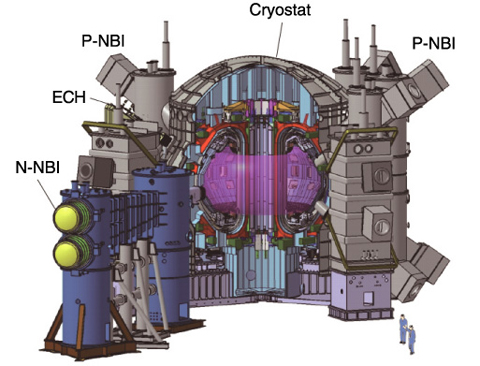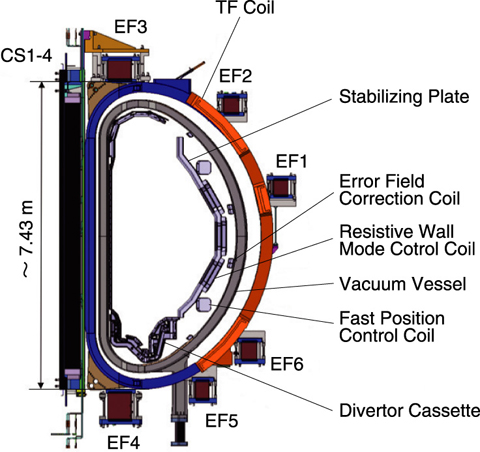
Fig.3-13 Bird's eye view of JT-60SA

Fig.3-14 Cross-sectional view of JT-60SA
Construction and exploitation of the JT-60SA (JT-60 Super Advanced) are being implemented at the JAEA Naka site under the Satellite Tokamak Program, which is to be undertaken as part of the Broader Approach agreement jointly implemented by Europe and Japan from 2007, and the Japanese national program. The mission of the JT-60SA project is to contribute to the early realization of fusion energy by supporting the exploitation of ITER and research towards DEMO by addressing key physics issues associated with these machines. The JT-60SA will be capable of confining break-even equivalent class high-temperature deuterium plasmas at a plasma current IP of 5.5 MA, a major radius of ~3 m and a toroidal field of 2.25 T, lasting for a duration ~100 s longer than the time scales characteristic of plasma processes such as current diffusion. It will pursue full non-inductive steady-state operation, with high plasma beta close to and exceeding no-wall ideal stability limits, and will establish ITER-relevant high density plasma regimes well above the H-mode power threshold (Fig.3-13).
Re-baselining of the project has been prompted by cost concerns and has been developed intensively since late 2007. In order to satisfy the plasma performance requirements, the machine has been coherently re-designed to cover the following specifications: a wide range of plasma equilibria with divertor configurations covering a higher plasma shaping factor of S~7, a lower aspect ratio of ~2.5, a high triangularity of κx~0.5, and a high elongation of δx~1.9; an inductive plasma current flattop and additional heating up to 41 MW for 100 s; divertor targets to withstand up to 15 MW/m2; N-NBI having high beam energy up to 500 keV; internal coils for RWM stabilization equipped with a stabilizing shell; and in-vessel components such as divertor cassettes to be compatible with remote maintenance (Fig.3-14).
The re-baselining was completed in December 2008. The newly designed machine preserves all the scientific missions of the JT-60SA project, and is expected to meet its cost objectives, comply with additional design requirements, and add further flexibility features. In accordance with Procurement Arrangements between the Implementing Agencies of Fusion for Energy in Europe and JAEA in Japan, in 2009, manufacturing activities commenced with facilities for superconducting coils on the JAEA Naka site and a prototype vacuum vessel in the manufacturing factory. Thus, the JT-60SA project made a large step forward toward completion, in which the first plasma is foreseen to be in 2016.